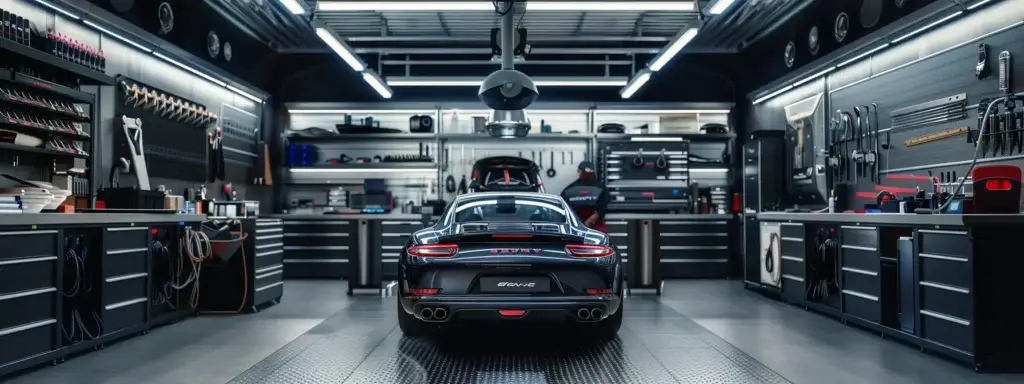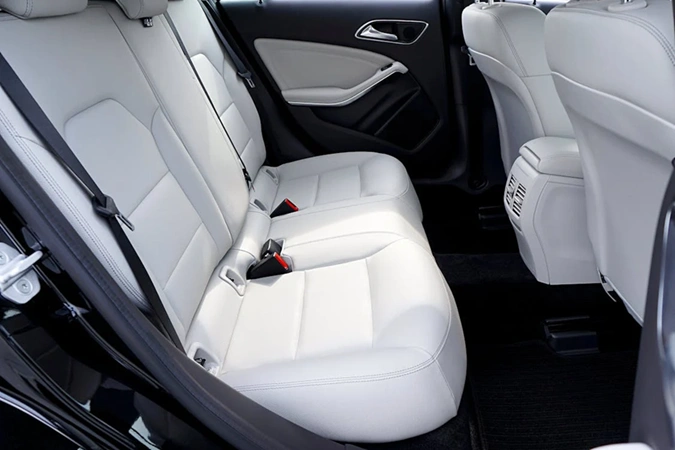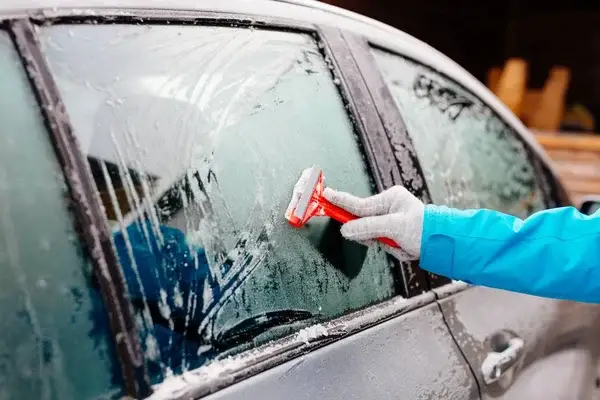- Mon - Fri: 8:00 AM - 4:00 PM / Sat: By Appointment / Sunday: Closed
- 0420 206 206
- Unit 41 / 566 Gardeners Rd, Alexandria NSW 2015
Complete DIY Car Interior Detailing Guide Like a Pro

Jump to...
Introduction
Maintaining a clean car interior is vital for preserving your vehicle’s value and ensuring a comfortable driving experience. DIY auto-detailing allows you to effectively remove grime, stains, and odours, keeping surfaces like leather seats and vinyl trim in pristine condition.
This guide is designed for car owners who want to detail their vehicles like a professional. By using the right cleaning products, microfiber cloths, and following proven detailing tips, you can keep your car’s interior spotless and extend its lifespan.
Essential Tools and Supplies for DIY Interior Detailing
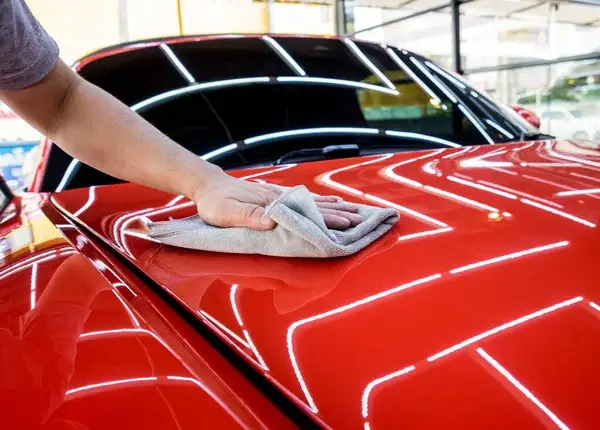
Microfiber Towels and Clothes
Using high-quality microfiber towels and cloths is essential for effective interior car detailing. These materials help prevent scratches and efficiently remove dirt, dust, and grime from various surfaces within your car.
Benefits of microfiber towels:
- Scratch Prevention: The soft fibres minimise the risk of scratching delicate surfaces like dashboards and leather seats.
- High Absorbency: Microfiber towels can absorb significant amounts of liquid, making them ideal for wiping spills and removing moisture from carpets and upholstery.
- Versatility: Suitable for cleaning a wide range of materials, including vinyl, plastic, and glass, ensuring all interior surfaces remain spotless.
- Durability: High-quality microfiber cloths withstand frequent washing and maintain their effectiveness over time, offering a cost-effective solution for DIY detailing.
Tips for using microfiber towels:
- Color-Coding: Assign specific colours to different tasks to avoid cross-contamination. For example:
- White Towels: Perfect for cleaning glass and neutral surfaces to easily identify dirt and streaks.
- Coloured Towels: Use distinct colours for wiping down leather, vinyl, and plastic to maintain cleanliness without mixing contaminants.
- Separate Usage: Use dedicated towels for specific areas, such as floor mats and dashboards, to ensure thorough and safe cleaning.
Appropriate Cleaners and Protectants
Selecting the right cleaners and protectants is crucial for maintaining and preserving the various materials in your car’s interior. Each type of surface requires specialised products to ensure effective cleaning without causing damage.
Types of Cleaners:
- Leather Cleaners: Specifically formulated to clean and nourish leather seats, removing stains and preventing drying or cracking.
- Vinyl Cleaners: Designed to clean vinyl surfaces like door panels and dashboards without leaving residues or damaging the material.
- Plastic Cleaners: Ideal for cleaning plastic trim and other hard surfaces, effectively removing dust and grime without causing discoloration.
Role of Protectants:
- Leather Protectants: Maintain the suppleness of leather seats and reduce wear from daily use.
- Vinyl Protectants: Shield vinyl surfaces from UV damage, preventing fading and cracking over time.
- General Interior Protectants: Provide a protective barrier to all plastic and vinyl surfaces, keeping them clean and extending their lifespan.
- Compatibility: Ensure products are compatible with the specific materials in your car interior to avoid adverse reactions.
- Test First: Always test cleaners and protectants on a small, inconspicuous area to verify they do not cause discoloration or damage.
- Follow Instructions: Adhere to the manufacturer’s guidelines for application and usage to achieve the best results.
Best Practices:
- Dedicated Products: Use separate cleaners for different materials to maintain the integrity of each surface.
- Regular Maintenance: Apply protectants regularly to preserve the condition of interior materials and keep your car looking like new.
- Comprehensive Coverage: Ensure all interior surfaces, including less-visible areas, receive appropriate cleaning and protection to maintain a thoroughly clean environment.
By using the appropriate cleaners and protectants, you can effectively maintain the beauty and functionality of your car’s interior, keeping it clean and protected like a pro.
Experience the Glosshaus Difference
Ride with confidence. Contact us now to schedule a professional detailing service.
Step-by-Step Interior Detailing Process
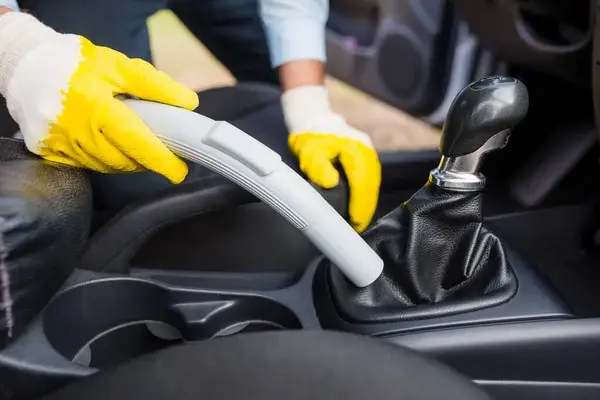
Vacuuming and Removing Debris
Thorough vacuuming is the foundation of a clean car interior. Start by removing all loose dirt, crumbs, and debris from the seats, carpets, and floor mats. Use a vacuum with assorted attachments to reach hard-to-access areas such as under the seats, between cushions, and around the pedals. Pay special attention to high-traffic zones where grime tends to accumulate.
Key steps for effective vacuuming:
- Remove Floor Mats: Take out the floor mats and vacuum them separately to ensure all dirt is eliminated. Shake them out to dislodge loose debris before vacuuming.
- Use the Right Attachments: Utilise crevice tools for tight spaces, upholstery brushes for fabric seats, and narrow nozzles for vents and buttons.
- Vacuum in Multiple Directions: Move the vacuum nozzle in different directions to lift and remove embedded dirt from the carpet fibres and upholstery.
- Clean the Trunk: Don’t forget to vacuum the trunk area thoroughly, removing any hidden debris that can contribute to unpleasant odours.
Regular vacuuming maintains a spotless interior and prolongs the life of your car’s upholstery and carpets by preventing dirt buildup that can cause wear and tear.
Cleaning and Protecting Surfaces
After vacuuming, the next step is to clean and protect all interior surfaces. Different materials require specific cleaners and protectants to maintain their appearance and durability.
Essential cleaning methods:
- Dashboard and Console: Use a dedicated interior cleaner to wipe down the dashboard, console, and other plastic surfaces. Apply the cleaner with a microfiber cloth to avoid scratches and streaks.
- Leather Seats: For leather surfaces, apply a high-quality leather cleaner followed by a leather conditioner. This not only removes stains and grime, but also keeps the leather supple and prevents cracking.
- Fabric Seats and Carpets: Use a fabric cleaner to treat stains on cloth seats and carpets. For deeper cleaning, consider using a steam cleaner to penetrate the fibres and remove stubborn dirt.
- Door Panels and Trim: Clean the door panels and trim with an appropriate interior cleaner. Use a soft brush to agitate any dirt in textured areas before wiping clean with a microfiber cloth.
Protecting surfaces ensures they remain in excellent condition:
- Apply Protectants: Once cleaned, apply protectants to plastic and vinyl surfaces to guard against UV damage and fading. Products like vinyl protectant sprays create a barrier that repels dust and prevents discoloration.
- Use Glass Cleaner: Clean all interior windows and mirrors with an ammonia-free glass cleaner to achieve a streak-free shine. Finish with a dry microfiber cloth for optimal clarity.
- Condition Leather: Regularly condition leather surfaces to maintain their natural oils and prevent dryness. A good leather conditioner also enhances the richness and sheen of the leather.
By following these cleaning and protection steps, you can ensure that your car’s interior not only looks pristine, but also remains comfortable and resilient against everyday wear and environmental factors.
Secure Your Detail Now
Availabilities are limited. Make a booking today or call us to get started.
Deep Cleaning Techniques for a Pristine Interior
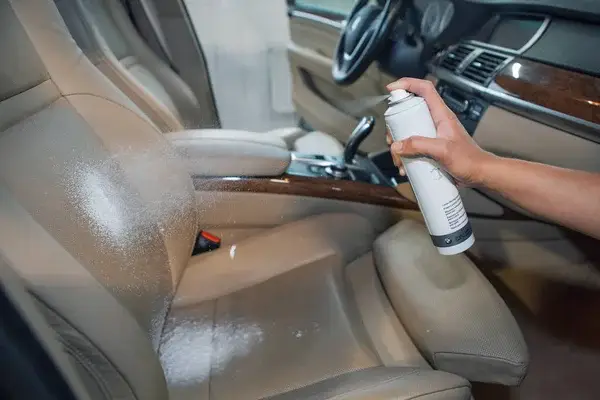
Handling Stubborn Stains
Removing tough stains from your car’s interior requires the right techniques and cleaners to ensure surfaces remain undamaged. Here’s how to tackle stubborn stains effectively:
- Identify the Stain Type: Determine whether the stain is oil-based, protein-based, or dye-based. This helps in selecting the appropriate cleaner.
Use Specialised Cleaners:
- For leather seats, apply a leather cleaner. Pre-treat the area with a conditioner to protect the material before using the cleaner.
- For fabric upholstery and carpets, use a carpet and upholstery cleaner. Products like spot stain removers can target specific blemishes without saturating the material.
Apply and Agitate:
- Spray the cleaner directly onto the stain.
- Use a soft-bristle brush or a microfiber cloth to gently scrub the area in circular motions. This helps lift the stain from the fibres without causing scratches.
Rinse and Dry:
- Wipe away the cleaner with a clean microfiber towel.
- Allow the area to air dry completely to prevent any residue from setting in.
Repeat if Necessary: Some stubborn stains may require multiple applications. Patience and repeated treatments can yield the best results.
By following these steps, you can effectively remove stubborn stains and maintain a spotless interior.
Eliminating Unpleasant Odours
Unpleasant odours in your car can make every drive uncomfortable. Here’s how to neutralise and remove these unwanted smells:
- Identify the Source: Common odour sources include spilled liquids, pet hair, smoke, and accumulated dirt. Pinpointing the origin helps in addressing the issue effectively.
Use Odour Eliminators:
- Odour Bombs are effective in neutralising persistent odours. These products release chlorine dioxide, which eliminates bacteria and viruses causing the smells.
- Alternatively, use specialised door-eliminating sprays that break down odour molecules rather than just masking them.
Thorough Cleaning:
- Vacuum all areas, including under the seats and in crevices, to remove loose debris and pet hair.
- Wipe Down Surfaces with a damp microfiber cloth and a suitable interior cleaner to eliminate residues that contribute to odours.
Apply Protectants:
- For fabric surfaces, consider using door-neutralising conditioners that maintain freshness and repel dirt.
- For fabric surfaces, consider using door-neutralising conditioners that maintain freshness and repel dirt.
Ventilate the Car:
- After applying odour eliminators, leave the windows open or use the car’s ventilation system on high to circulate fresh air and expedite the drying process.
Regular Maintenance:
- Implement a routine cleaning schedule to prevent the buildup of dirt and moisture, which can lead to lingering odours.
By utilising these methods, you can ensure your car’s interior remains fresh and inviting, free from unpleasant smells.
Experience the Glosshaus Difference
Ride with confidence. Contact us now to schedule a professional detailing service.
Maintenance Tips to Keep Your Car Interior Like New

Establishing a Regular Cleaning Schedule
Maintaining a consistent cleaning routine is essential for preserving the quality of your car’s interior. Regular cleaning prevents the buildup of dirt, grime, and stains, ensuring that your car remains comfortable and retains its value over time.
Monthly Maintenance:
- Vacuuming: Use a high-quality vacuum with appropriate attachments to thoroughly clean the carpets, seats, and floor mats. Pay special attention to hard-to-reach areas where debris can accumulate.
- Wiping Surfaces: Utilise microfiber towels to gently wipe down the dashboard, door panels, and other hard surfaces. This helps remove dust and prevents grime buildup.
- Spot Cleaning: Address any spills or stains immediately using suitable cleaners. For leather seats, apply a dedicated leather cleaner, while vinyl surfaces should be treated with a vinyl-specific cleaner.
Quarterly Deep Cleans:
- Comprehensive Vacuuming: Deep clean the carpets and upholstery to remove embedded dirt and pet hair. Consider using a carpet cleaner or steam cleaner for a more thorough clean.
- Protectant Application: Apply protectants to plastic and vinyl surfaces to shield them from UV damage and everyday wear and tear. This helps maintain their appearance and extend their lifespan.
- Floor Mat Cleaning: Remove floor mats and clean them separately using a carpet cleaner or an all-purpose cleaner. Ensure they are completely dry before placing them back in the car.
Protecting Interior Surfaces from Wear and Tear
Protecting your car’s interior surfaces is crucial for maintaining a fresh and pristine appearance. Implementing protective measures can significantly reduce the impact of daily use and environmental factors on your vehicle’s interior.
Use of Protectants:
- Dashboard and Trim: Apply a high-quality protectant to the dashboard, door panels, and other plastic or vinyl surfaces. Protectants create a barrier against UV rays, preventing fading and cracking.
- Leather Conditioning: Regularly condition leather seats with a specialised leather conditioner. This keeps the leather supple, prevents cracking, and enhances its natural lustre.
Avoiding Direct Sunlight:
- Window Shades: Utilise sunshades or tint your windows to minimise direct sunlight exposure. This reduces heat buildup and protects interior surfaces from UV damage.
- Parking Strategies: Whenever possible, park in shaded areas or use a car cover to shield your vehicle from harsh sunlight and reduce interior wear.
Handling Spills and Stains:
- Immediate Action: Promptly clean up any spills using appropriate cleaners to prevent stains from setting. Use a microfiber cloth for gentle and effective cleaning.
- Dedicated Cleaning Supplies: Keep a set of interior cleaners, microfiber towels, and brushes in your car for quick access. This ensures you can address messes as they occur, maintaining a clean and protected interior.
Regular Inspections:
- Routine Checks: Periodically inspect your car’s interior for signs of wear and tear, such as cracks in the dashboard or fading of upholstery. Early detection allows for timely maintenance and repairs.
- Addressing Issues Promptly: If you notice any damage, take immediate steps to repair or treat the affected areas. This helps prevent further deterioration and preserves the overall condition of your car’s interior.
By establishing a regular cleaning schedule and taking proactive steps to protect interior surfaces, you can ensure that your car’s interior remains like new for years to come.
Secure Your Detail Now
Availabilities are limited. Make a booking today or call us to get started.
Common Mistakes to Avoid in DIY Interior Detailing
Using Incorrect Cleaning Products
Using unsuitable cleaning products can cause significant damage to your car’s interior surfaces. Incorrect cleaners may lead to:
- Discoloration: Harsh chemicals can fade or stain upholstery and trim.
- Material Degradation: Certain cleaners can strip away natural oils from leather or weaken vinyl surfaces.
- Residue Buildup: Improper products may leave residues that attract more dirt and grime.
Best Practices:
- Choose Automotive-Specific Cleaners: Always select cleaners designed for car interiors to ensure they are safe for materials like leather, vinyl, and plastic.
- Avoid Household Cleaners: Products like dish soap can be too harsh, removing protective wax and damaging surfaces.
- Test First: Apply any new cleaner to a small, inconspicuous area to check for adverse reactions before widespread use.
Neglecting Hidden or Less-Visible Areas
Overlooking certain areas can result in an incomplete cleaning job and allow grime to build up over time. Commonly neglected spots include:
- Under Seats and Between Cushions: Dirt and debris often accumulate in these hidden areas.
- Door Pockets and Trunk: These compartments can trap crumbs, wrappers, and other small items.
- Air Vents and Controls: Dust can settle on vents and around buttons, affecting both cleanliness and functionality.
- Floor Mats and Carpets: Besides visible surfaces, deeper layers may harbour stains and odours.
Effective Strategies:
- Use Appropriate Tools: Utilise crevice tools and soft brushes to reach tight spaces without causing damage.
- Vacuum Thoroughly: Ensure you vacuum all areas, including under seats and in door pockets, to remove embedded dirt.
- Regular Inspection: Periodically check and clean these less-visible areas to maintain a consistently clean interior.
Avoiding these common mistakes ensures that your DIY interior detailing efforts are effective and help maintain the longevity and aesthetic of your car’s interior.
Experience the Glosshaus Difference
Ride with confidence. Contact us now to schedule a professional detailing service.
Conclusion
DIY interior car detailing offers numerous benefits, including maintaining your vehicle’s value and ensuring a comfortable driving experience. By using high-quality microfiber towels, appropriate cleaners, and protectants, you can effectively remove grime, stains, and odours from your car’s interior surfaces like leather seats and vinyl trim. Following a step-by-step detailing process—from thorough vacuuming and cleaning to deep cleaning stubborn stains and eliminating unpleasant odours—ensures that your car’s interior remains spotless and resilient against everyday wear and tear.
Ready to detail your car’s interior like a pro? Contact Glosshaus Bespoke Detailing today to schedule your paint protection service in Sydney, NSW Australia. Our expert technicians utilise industry-leading techniques and premium cleaning products to keep your car’s interior clean, protected, and looking its best. Take the first step towards a pristine vehicle and experience our unparalleled expertise in auto-detailing.
Frequently Asked Questions
High-quality microfiber towels with an 80/20 polyester/polyamide blend and a weight between 300 and 500 GSM are best for interior detailing. Color-code towels for different tasks to prevent cross-contamination and choose durable towels that withstand frequent washing.
Detail your car’s interior at least monthly for regular maintenance, including vacuuming and wiping surfaces. A deeper clean every three to six months is recommended for pristine condition.
No, avoid using household cleaners as they can damage delicate surfaces and strip protective coatings. Use automotive-specific cleaners and protectants for best results.
Failing to detail your car regularly can contribute to various health issues, including respiratory problems, hygiene risks, and allergies. Dust, bacteria, mould, and allergens can accumulate inside the vehicle, circulating through the air vents and potentially causing respiratory irritation, allergic reactions, and other health concerns.
Apply a specialised upholstery cleaner directly to the stain and gently scrub with a soft-bristle brush. For persistent stains, consider a steam cleaner.
Use odour eliminators like Odour Bombs and thoroughly clean all interior surfaces. This combination neutralises odours and removes their sources.
Yes, apply protectants after cleaning to preserve surfaces and protect against future wear and tear. Use protectants designed for specific materials like leather, vinyl, and plastic.
Avoid using incorrect cleaning products, like household cleaners, which can damage surfaces. Also, don’t neglect cleaning hidden or less-visible areas.
Perform regular quick cleans, use organisers to manage clutter, and address spills and dirt immediately. These habits will help maintain cleanliness between deep cleanings.
Table of Contents

Ready to Shine?
Secure Your Detail Now
We provide 5-Star quality detailing,
Guaranteed
Recent Insights
Have you ever wondered what’s lurking in your car seats? Professional car seat cleaning is essential for maintaining a healthy, comfortable driving environment. This article
Is your car looking dull and neglected? A professional car wash offers more than just a quick rinse. This guide explores the key differences between
Car Detailing
Rediscover the joy of driving a flawlessly clean car.
New Car Protection
Protect your investment and keep your new car looking showroom-new.
Paint Protection Film (PPF)
Drive with confidence knowing your paint is shielded from everyday hazards.
Motorbike Detailing
Give your bike the specialised care it deserves for peak performance and head-turning shine.


